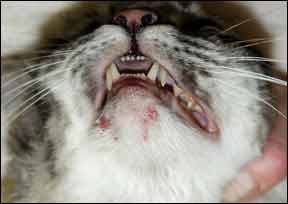Despite its typical durability, a cat’s skin is subject to a wide array of disorders. Most of these conditions, in themselves, are of minor consequence and readily treatable. But all of them merit examination by a veterinarian, since they can signal the presence of a serious infection or other potentially life threatening systemic health problem.

288
Among the various feline skin conditions that might be overlooked — or ignored — by an owner is acne. This disorder, which is characterized by the emergence of tiny black eruptions (blackheads) on a cat’s chin and lips, is a condition that can afflict both male and female cats of all ages and breeds.
The presence of blackheads usually amounts to nothing more than a cosmetic problem, says William H. Miller, Jr., VMD, a professor of dermatology and medical director of the Companion Animal Hospital at Cornell University’s College of Veterinary Medicine. However, he points out, feline acne — which appears only on an affected cat’s face — can evolve into a more serious health issue if the benign blackheads turn into pus-filled boils (furuncles) that may signal the presence of a deep-seated bacterial or fungal infection. This will become a painful condition that requires appropriate treatment.
Clearly Apparent. “You don’t have to routinely examine your cat’s face to discover blackheads,” he says. “Unless you have very poor eyesight, you’ll notice them.” If the cat has a half-dozen or even as many as 20 blackheads, notes Dr. Miller, there is probably no cause for concern. But some cats will have hundreds of them. In that case, it’s time for a visit to a veterinarian for proper prophylaxis and specific acne treatment.
A blackhead forms when excess keratin — an insoluble protein that is the chief constituent of hair — collects in a hair follicle, the slender, tubular shaft that contains the root of a hair. Over time, a sufficient collection of oily keratin debris can plug the hair follicle. “If there are bacteria, yeast, or other infectious agents sealed in by the plug,” says Dr. Miller, “a furuncle may develop. Then there is pus down below the surface of the skin, and that can spread from one pimple to another and eventually to the entire chin. This happens rarely, but when it does the infection can progress to a systemic illness.”
A more common and immediately pressing problem, he notes, is the discomfort caused by the presence of the furuncles. “These lesions are very tender, very painful,” says Dr. Miller, “and if a cat keeps banging its chin on its food bowl, the animal may eventually go off its food.” Feline acne, he points out, then becomes an issue not only of the affected cat’s comfort but also of her overall health. “It’s not a skin condition that, in itself, can kill a cat,” he adds. “But if it is ignored by the owner, the animal is apt to become very uncomfortable.”
Although the specific cause or causes of feline acne are unknown, there exist several possible explanations for the condition. Commonly suspected causes include dirty, bacteria-laden food and water bowls; allergies; genetic predisposition; poor grooming habits; clogged hair follicles resulting from inadequate shedding; defects in keratin production; and the overproduction of sebum, a waxy substance produced by the sebaceous glands in the skin.
Simple acne can theoretically be safely ignored, says Dr. Miller. “The blackheads come and go,” he notes. “The great majority of cats never get them; some get them once, but then they go away and never appear again.”
Addressing the Problem. After examining an acne-ridden cat, a veterinarian may conclude that the owner can treat the condition at home. This can be achieved through the gentle application to the animal’s lips and chin of such over-the-counter products as hydrogen peroxide, alcohol, mouthwash, and certain medicated acne pads designed for human use.
Treatment of severe feline acne — marked by, for example, the presence of a large pimple or furuncle — is considerably more complicated and will require veterinary attention. The first objective, says Dr. Miller, is to determine whether there is a true infection and, if so, whether its source is bacterial or fungal. Medication will be determined accordingly, with appropriate antibacterial or antifungal drugs. These medications will be used either topically or — if the infection appears to be severe — systemically. Just be sure to ask your veterinarian’s recommendation for a cat-appropriate treatment regimen.



